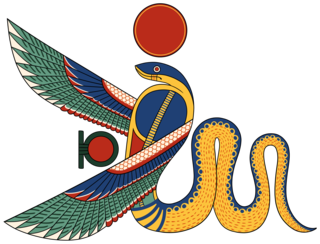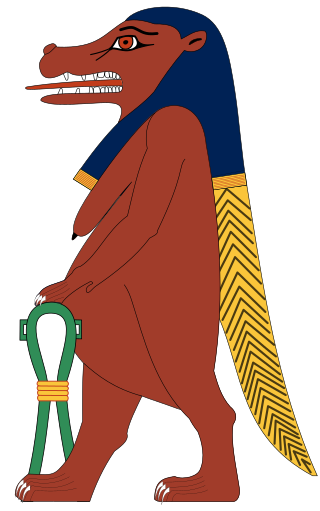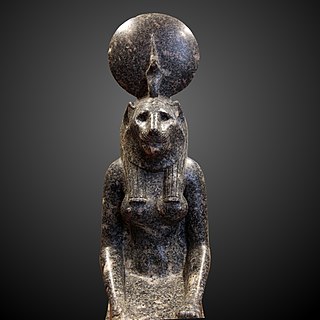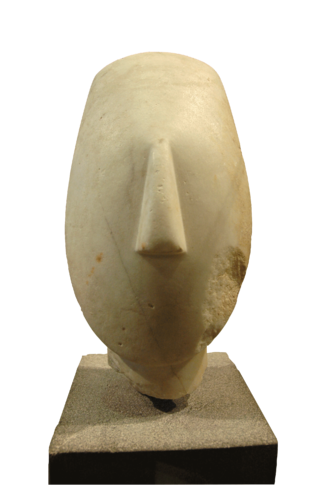External links
-
 Media related to Snake goddesses at Wikimedia Commons
Media related to Snake goddesses at Wikimedia Commons
A snake goddess is a goddess associated with a snake theme.
Examples include:

In ancient Greek religion and mythology, Demeter is the Olympian goddess of the harvest and agriculture, presiding over crops, grains, food, and the fertility of the earth. Although she is mostly known as a grain goddess, she also appeared as a goddess of health, birth, and marriage, and had connections to the Underworld. She is also called Deo (Δηώ). In Greek tradition, Demeter is the second child of the Titans Rhea and Cronus, and sister to Hestia, Hera, Hades, Poseidon, and Zeus. Like her other siblings but Zeus, she was swallowed by her father as an infant and rescued by Zeus.

An oracle is a person or thing considered to provide wise and insightful counsel or prophetic predictions, most notably including precognition of the future, inspired by deities. If done through occultic means, it is a form of divination.

In Greek mythology, Amalthea or Amaltheia is the most-frequently mentioned foster-mother of Zeus.

The Minoan civilization was a Bronze Age culture which was centered on the island of Crete. Known for its monumental architecture and its energetic art, it is often regarded as the first civilization in Europe.

Renenūtet was a goddess of nourishment and the harvest in the ancient Egyptian religion. The importance of the harvest caused people to make many offerings to Renenutet during harvest time. Initially, her cult was centered in Terenuthis. Renenutet was depicted as a cobra or as a woman with the head of a cobra.

Wadjet, known to the Greek world as Uto or Buto among other renderings including Wedjat, Uadjet, and Udjo, was originally the ancient Egyptian local goddess of the city of Dep. It became part of the city that the Egyptians named Per-Wadjet and the Greeks called Buto, also being the capital of the 6th lower Egyptian nome, Wadjet it's patron deity, which was an important site in prehistoric Egypt and the cultural developments of the Paleolithic. There was also a Per-Wadjet in Upper Egypt.

In Mesopotamian mythology, Lamashtu was a female demon/monster/malevolent goddess or demigoddess who menaced women during childbirth and, if possible, kidnapped their children while they were breastfeeding. She would gnaw on their bones and suck their blood, and was charged with a number of other evil deeds. She was a daughter of the Sky God Anu.
A knot is a fastening in rope or interwoven lines.

In Ancient Egyptian religion, Taweret is the protective ancient Egyptian goddess of childbirth and fertility. The name "Taweret" means "she who is great" or simply "great one", a common pacificatory address to dangerous deities. The deity is typically depicted as a bipedal female hippopotamus with feline attributes, pendulous female human breasts, the limbs and paws of a lion, and the back and tail of a Nile crocodile. She commonly bears the epithets "Lady of Heaven", "Mistress of the Horizon", "She Who Removes Water", "Mistress of Pure Water", and "Lady of the Birth House".

Unut, also known as Wenut or Wenet, was a prehistoric Ancient Egyptian hare and snake goddess of fertility and new birth.

In Egyptian mythology, Pakhet, Egyptian Pḫ.t, meaning she who scratches is a lioness goddess of war.

Aegean art is art that was created in the lands surrounding, and the islands within, the Aegean Sea during the Bronze Age, that is, until the 11th century BC, before Ancient Greek art. Because is it mostly found in the territory of modern Greece, it is sometimes called Greek Bronze Age art, though it includes not just the art of the Mycenaean Greeks, but also that of the non-Greek Cycladic and Minoan cultures, which converged over time.


Two Minoan snake goddess figurines were excavated in 1903 in the Minoan palace at Knossos in the Greek island of Crete. The decades-long excavation programme led by the English archaeologist Arthur Evans greatly expanded knowledge and awareness of the Bronze Age Minoan civilization, but Evans has subsequently been criticised for overstatements and excessively speculative ideas, both in terms of his "restoration" of specific objects, including the most famous of these figures, and the ideas about the Minoans he drew from the archaeology. The figures are now on display at the Heraklion Archaeological Museum (AMH).

Minoan religion was the religion of the Bronze Age Minoan civilization of Crete. In the absence of readable texts from most of the period, modern scholars have reconstructed it almost totally on the basis of archaeological evidence of such as Minoan paintings, statuettes, vessels for rituals and seals and rings. Minoan religion is considered to have been closely related to Near Eastern ancient religions, and its central deity is generally agreed to have been a goddess, although a number of deities are now generally thought to have been worshipped. Prominent Minoan sacred symbols include the bull and the horns of consecration, the labrys double-headed axe, and possibly the serpent.
A scorpion goddess is a goddess associated with a scorpion theme.

The name poppy goddess is often used for a famous example of a distinctive type of large female terracotta figurine in Minoan art, presumably representing a goddess, but not thought to be cult images, rather votive offerings. It was discovered in a sanctuary of the Post-palace period at Gazi, Crete, and is now in the Heraklion Archaeological Museum.

Desert God is a novel by author Wilbur Smith first published in 2014. It is part of a series of novels by Smith set to Ancient Egypt and follows the fate of the Egyptian Kingdom through the eyes of Taita, a multi-talented and highly skilled eunuch slave.
Idaea or Idaia is the name of several figures in Greek mythology, it means "she who comes from Ida" or "she who lives on Ida", and is often associated with Mount Ida in Crete, and Mount Ida in the Troad.
Minoan snake tubes are cylindrical ceramic tubes with a closed, splayed out bottom. Sir Arthur Evans interpreted them as "snake tubes", that is vessels for carrying or housing snakes used in Minoan religion. They are now usually interpreted as "offering stands", on which kalathoi, or offering bowls were placed in shrines. They are described as varying in material and construction despite sharing a common purpose. In the context of domestic shrines snake tubes are believed to have sat on top of or adjacent to a cult bench. In between the tubes would have been a goddess figurine and plaque which featured animal depictions.